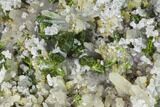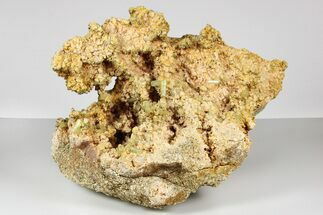This Specimen has been sold.
3.9" Lustrous Epidote, Calcite & Quartz Association - Morocco
This is a beautiful mineral association that contains pistachio-green epidote crystals in bow tie and fan shaped aggregates and calcite crystals on a bed of quartz. The specimen was collected at Imilchil in the Er Rachidia Province of Morocco.
It comes with an acrylic display stand.
It comes with an acrylic display stand.
About Epidote
Epidote is a striking and often green mineral known for its complex crystal structure and vitreous luster. It is a calcium aluminum iron silicate that commonly forms in metamorphic rocks, particularly in regions that have undergone low to medium-grade metamorphism. The color of epidote typically ranges from pistachio green to dark green, although it can occasionally appear yellowish-green or even brown due to varying iron content.
Epidote crystals can appear in prismatic, slender forms or as aggregates, and they often exhibit striations along their length. The mineral’s translucent to transparent appearance and high refractive index give it an attractive, glassy shine.
It is commonly associated with minerals such as quartz, feldspar, and garnet, often forming in metamorphic rocks like schist and gneiss. It can also be found in skarn deposits alongside minerals like calcite, diopside, and amphiboles. These associations can provide insights into the geologic history and metamorphic conditions of the region. Epidote is found in locations worldwide, with notable sources including Austria, Norway, Pakistan, and parts of the United States. Collectors prize epidote for its unique green hues and well-formed crystal clusters.
Epidote is a striking and often green mineral known for its complex crystal structure and vitreous luster. It is a calcium aluminum iron silicate that commonly forms in metamorphic rocks, particularly in regions that have undergone low to medium-grade metamorphism. The color of epidote typically ranges from pistachio green to dark green, although it can occasionally appear yellowish-green or even brown due to varying iron content.
Epidote crystals can appear in prismatic, slender forms or as aggregates, and they often exhibit striations along their length. The mineral’s translucent to transparent appearance and high refractive index give it an attractive, glassy shine.
It is commonly associated with minerals such as quartz, feldspar, and garnet, often forming in metamorphic rocks like schist and gneiss. It can also be found in skarn deposits alongside minerals like calcite, diopside, and amphiboles. These associations can provide insights into the geologic history and metamorphic conditions of the region. Epidote is found in locations worldwide, with notable sources including Austria, Norway, Pakistan, and parts of the United States. Collectors prize epidote for its unique green hues and well-formed crystal clusters.
About Quartz
Quartz is the name given to silicon dioxide (SiO2) and is the second most abundant mineral in the Earth's crust. Quartz crystals generally grow in silica-rich environments--usually igneous rocks or hydrothermal environments like geothermal waters--at temperatures between 100°C and 450°C, and usually under very high pressure. In either case, crystals will precipitate as temperatures cool, just as ice gradually forms when water freezes. Quartz veins are formed when open fissures are filled with hot water during the closing stages of mountain formation: these veins can be hundreds of millions of years old.
Quartz is the name given to silicon dioxide (SiO2) and is the second most abundant mineral in the Earth's crust. Quartz crystals generally grow in silica-rich environments--usually igneous rocks or hydrothermal environments like geothermal waters--at temperatures between 100°C and 450°C, and usually under very high pressure. In either case, crystals will precipitate as temperatures cool, just as ice gradually forms when water freezes. Quartz veins are formed when open fissures are filled with hot water during the closing stages of mountain formation: these veins can be hundreds of millions of years old.
About Calcite Crystals
Calcite crystals are a form of calcium carbonate (CaCO₃) known for their diverse shapes, transparency, and vibrant range of colors. They typically form in rhombohedral, scalenohedral, or prismatic shapes, often with well-defined, sharp edges and glossy surfaces. Calcite crystals are often translucent or transparent, sometimes displaying a double refraction effect where objects viewed through the crystal appear doubled. They can appear in various colors—white, clear, yellow, pink, blue, green, and orange—depending on impurities or trace minerals.
A notable characteristic of calcite is its reaction with weak acids like vinegar, which causes it to effervesce, or fizz, as it releases carbon dioxide. This property makes calcite crystals a key tool in geological identification and studies. Calcite forms in many environments, from sedimentary rocks like limestone and marble to hydrothermal veins.
Calcite crystals are a form of calcium carbonate (CaCO₃) known for their diverse shapes, transparency, and vibrant range of colors. They typically form in rhombohedral, scalenohedral, or prismatic shapes, often with well-defined, sharp edges and glossy surfaces. Calcite crystals are often translucent or transparent, sometimes displaying a double refraction effect where objects viewed through the crystal appear doubled. They can appear in various colors—white, clear, yellow, pink, blue, green, and orange—depending on impurities or trace minerals.
A notable characteristic of calcite is its reaction with weak acids like vinegar, which causes it to effervesce, or fizz, as it releases carbon dioxide. This property makes calcite crystals a key tool in geological identification and studies. Calcite forms in many environments, from sedimentary rocks like limestone and marble to hydrothermal veins.
SPECIES
Epidote, Calcite & Quartz
LOCATION
Imilchil, Er Rachidia Province, Morocco.
SIZE
3.9 x 3.1"
CATEGORY
ITEM
#142734
 Reviews
Reviews














